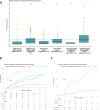Lifetime progression of IgA nephropathy: a retrospective cohort study with extended long-term follow-up
- PMID: 39833715
- PMCID: PMC11749578
- DOI: 10.1186/s12882-025-03958-y
Lifetime progression of IgA nephropathy: a retrospective cohort study with extended long-term follow-up
Abstract
Background: IgA nephropathy (IgAN) exhibits an unpredictable trajectory, creating difficulties in prognostication, monitoring, treatment, and research planning. This study provides a comprehensive depiction of the progression of kidney function throughout the disease course, from diagnosis to a span of 36 years post-diagnosis.
Methods: We utilized a cohort of 400 Norwegian IgAN patients, from diagnosis to the occurrence of death, initiation of kidney replacement therapy (KRT), or the latest follow-up. Recorded proteinuria (n = 2676) and creatinine (n = 8738) measurements were retrieved. Patients were divided into subgroups based on their specific estimated glomerular filtration rate (eGFR) slopes.
Results: Median follow-up was 16 years. During this period, 34% of patients either died or initiated KRT. Among patients who reached endpoint, the median duration from diagnosis to the initiation of KRT or death was 8 years. Notably, 34% of the cohort exhibited a stable disease course, characterized by an eGFR decline of less than 20% between two consecutive measurements. Differences in subsequent disease trajectories among two subgroups with similar eGFR levels at diagnosis could not be accounted for by variations in treatment strategies. Among patients with proteinuria < 1 g/24 h in less than half of the measurements, KRT was five times more prevalent compared to those with more than half of the measurements recording proteinuria < 1 g/24 h (p-value = 0.001).
Conclusions: While a significant proportion of IgAN patients reach kidney failure within their lifetimes, outcomes vary widely. Clinical data at diagnosis offer limited insights into long-term risks. Enhanced risk stratification necessitates data collection at multiple time points.
Keywords: Chronic renal failure; ESKD; Glomerulonephritis; IgA nephropathy; Proteinuria.
© 2025. The Author(s).
Conflict of interest statement
Declarations. Ethics approval and consent to participate: This study was approved by the Regional Ethics Committee of Western Norway (No. 2013/553). All the study participants provided informed consent. The research was done according to the Declaration of Helsinki. Consent for publication: Not applicable. Competing interests: The authors declare no competing interests.
Figures



References
-
- Wyatt RJ, Julian BA. IgA nephropathy. N Engl J Med. 2013;368(25):2402–14. - PubMed
-
- Knoop T, Vikse BE, Svarstad E, Leh S, Reisæter AV, Bjørneklett R. Mortality in patients with IgA nephropathy. Am J Kidney Dis. 2013;62(5):883–90. - PubMed
-
- Knoop T, Vikse BE, Mwakimonga A, Leh S, Bjørneklett R. Long-term outcome in 145 patients with assumed benign immunoglobulin A nephropathy. Nephrol Dial Transplant. 2017;32(11):1841–50. - PubMed
MeSH terms
LinkOut - more resources
Full Text Sources
Research Materials
Miscellaneous

